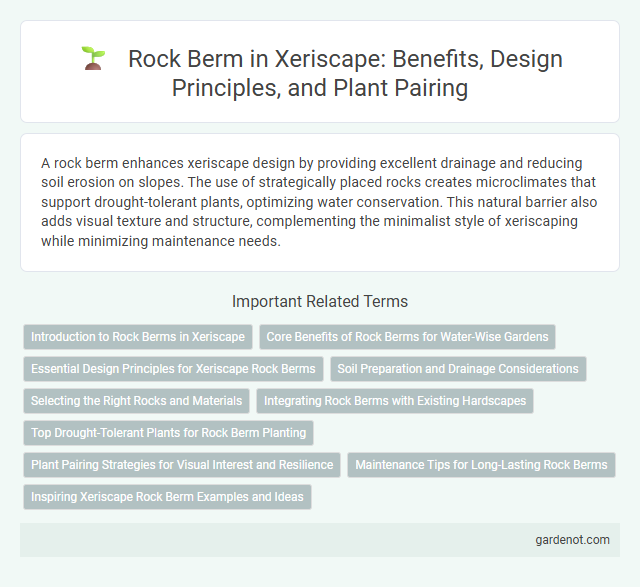A rock berm enhances xeriscape design by providing excellent drainage and reducing soil erosion on slopes. The use of strategically placed rocks creates microclimates that support drought-tolerant plants, optimizing water conservation. This natural barrier also adds visual texture and structure, complementing the minimalist style of xeriscaping while minimizing maintenance needs.
Introduction to Rock Berms in Xeriscape
Rock berms in xeriscape landscaping serve as natural erosion control features that also enhance water conservation by directing runoff toward plant roots. Constructed using a combination of gravel, stones, and drought-tolerant plants, rock berms create microclimates that reduce soil moisture evaporation and improve plant health. These structures integrate seamlessly into dry landscapes, offering both functional benefits and aesthetic appeal while minimizing irrigation needs.
Core Benefits of Rock Berms for Water-Wise Gardens
Rock berms enhance xeriscape gardens by improving drainage and reducing soil erosion, ensuring water efficiency in arid environments. Their porous structure facilitates deep water infiltration, promoting healthier plant roots while minimizing surface runoff. This natural barrier also supports diverse drought-tolerant plants, contributing to sustainable landscape design.
Essential Design Principles for Xeriscape Rock Berms
Rock berms in xeriscaping utilize strategic placement of rocks and soil to enhance water retention and reduce erosion. Essential design principles include selecting native, drought-tolerant plants, ensuring proper slope gradient for efficient water runoff, and integrating porous materials to facilitate soil aeration. Incorporating layers of organic mulch and creating varied textures improves moisture conservation and supports sustainable landscaping in arid environments.
Soil Preparation and Drainage Considerations
Rock berms in xeriscape design require well-prepared soil to ensure proper drainage and prevent water accumulation. Incorporating coarse sand or gravel into the soil mix enhances permeability, promoting efficient water runoff while reducing erosion risks. Properly graded soil with a slight slope away from the berm facilitates optimal drainage, supporting plant health and landscape longevity.
Selecting the Right Rocks and Materials
Selecting the right rocks and materials for a rock berm in xeriscaping involves choosing drought-tolerant, durable stones such as granite, basalt, or sandstone that retain heat and aid water conservation. Incorporate a mix of sizes, from large boulders to smaller pebbles, to enhance stability and promote efficient drainage while preventing soil erosion. Prioritize locally sourced materials to reduce environmental impact and ensure compatibility with the surrounding landscape.
Integrating Rock Berms with Existing Hardscapes
Rock berms enhance xeriscape designs by seamlessly blending with existing hardscapes such as patios, walkways, and retaining walls. Utilizing native stones and strategically layering them creates natural drainage while providing visual continuity and structural support. Integrating rock berms improves water conservation and offers durable, low-maintenance landscaping solutions that complement hardscape features.
Top Drought-Tolerant Plants for Rock Berm Planting
Rock berms create ideal microclimates that conserve moisture and reduce soil erosion, perfect for xeriscaping with drought-tolerant plants. Top choices include Lavender (Lavandula spp.), which thrives in rocky, well-drained soils, and Sedum (Sedum spp.), known for its succulent leaves and minimal water needs. Other excellent options are Russian Sage (Perovskia atriplicifolia) and California Lilac (Ceanothus spp.), both offering vibrant blooms and robust drought resilience.
Plant Pairing Strategies for Visual Interest and Resilience
Rock berms in xeriscaping enhance water conservation by directing runoff to drought-tolerant plants like lavender, sedum, and agave. Strategic plant pairing combines textures and heights, such as contrasting spiky yuccas with soft, low-growing succulents for visual interest. Incorporating native grasses alongside robust rock formations boosts resilience by improving soil stability and providing habitat diversity.
Maintenance Tips for Long-Lasting Rock Berms
Regularly inspecting rock berms for weed growth and removing debris prevents deterioration and maintains aesthetics. Applying a high-quality weed barrier fabric beneath the rocks minimizes invasive plants, reducing maintenance efforts. Periodic replenishment of rocks and re-compacting soil ensures structural stability and enhances water runoff management over time.
Inspiring Xeriscape Rock Berm Examples and Ideas
Xeriscape rock berms transform dry landscapes by incorporating layered stone terraces that enhance water retention and minimize erosion. Popular designs feature natural boulders combined with drought-tolerant plants like succulents, ornamental grasses, and native wildflowers to create visually striking, low-maintenance garden focal points. Creative variations include curved berm shapes, mixed rock sizes, and strategic placement for maximizing shade and moisture conservation in arid climates.
Rock berm Infographic

 gardenot.com
gardenot.com